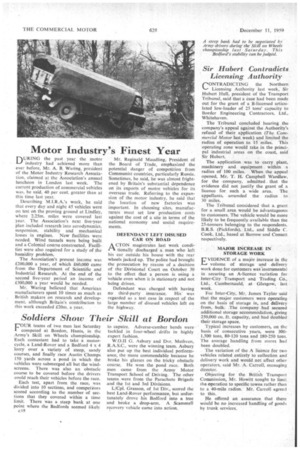Motor Industry's Finest Year
Page 54

If you've noticed an error in this article please click here to report it so we can fix it.
nURING the past year the motor
industry had achieved more than ever before, Mr. A. B. Waring, president of the Motor Industry Research Association, claimed at the Association's annual luncheon in London last week. The current production of commercial vehicles was. he said, 40 per cent. greater than at this time last year.
Describing M.I.R.A.'s work, he said that every day and night 45 vehicles were on test on the proving ground at Lindley, where 2.25m. miles were covered last year. The Association's next five-year plan included research into aerodynamics, suspension, stability and mechanical losses in engines. New facilities were needed. Wind tunnels were being built and a Colonial course constructed. Facilities were also required for a study of the humidity problem.
The Association's present income was U00,000 a year. of which £60,000 came from the Department of Scientific and Industrial Research. At the end of the second five-year period an income of 000,000 a year would be needed.
Mr. Waring believed that American manufacturers spent 10 times as much as British makers on research and development, although Britain's contribution to this work exceeded £20m. a year. Mr. Reginald Maudling, President of the Board of Trade, emphasized the potential danger of competition from Communist countries, particularly Russia. Sometimes, he said, he was almost frightened by Britain's substantial dependence on its exports of motor vehicles for its overseas trade, Referring to the expansion of the motor industry, he said that the location of new factories was important. In choosing sites, manufacturers must set low production costs against the cost of a site in terms of the national economy and social requirements.
DEFENDANT LEFT DISUSED CAR ON ROAD
A CTON magistrates last week condi
tionally discharged a man who left his car outside his house with the rear wheels jacked up. The police had brought the prosecution by reason of a decision of the Divisional Court on October 30 to the effect that a person is using a vehicle even when it is stationary and not being driven.
Defendant was charged with having no third-party insurance. His was regarded as a test case in respect of the large number of disused vehicles left on the highway.
























































































































